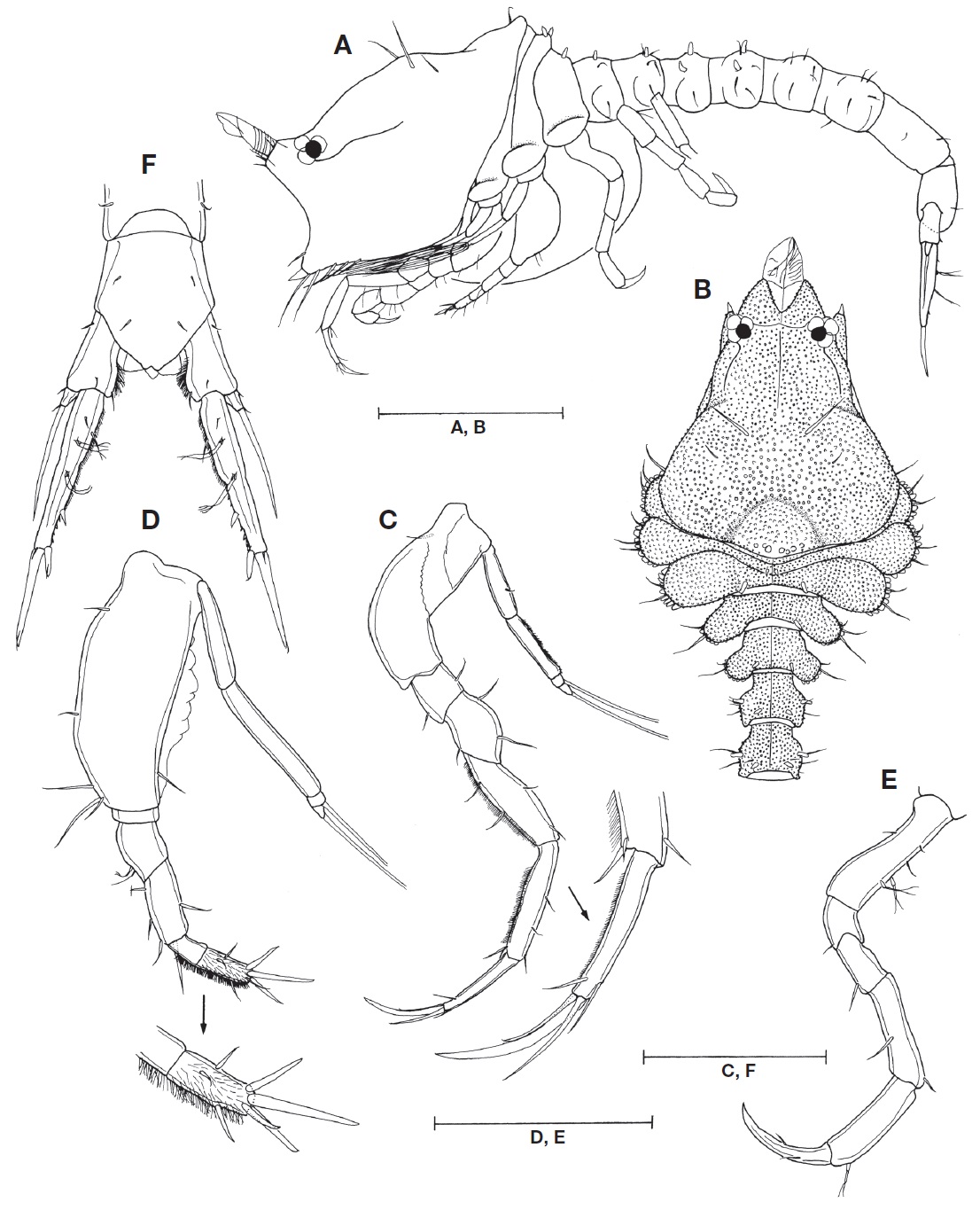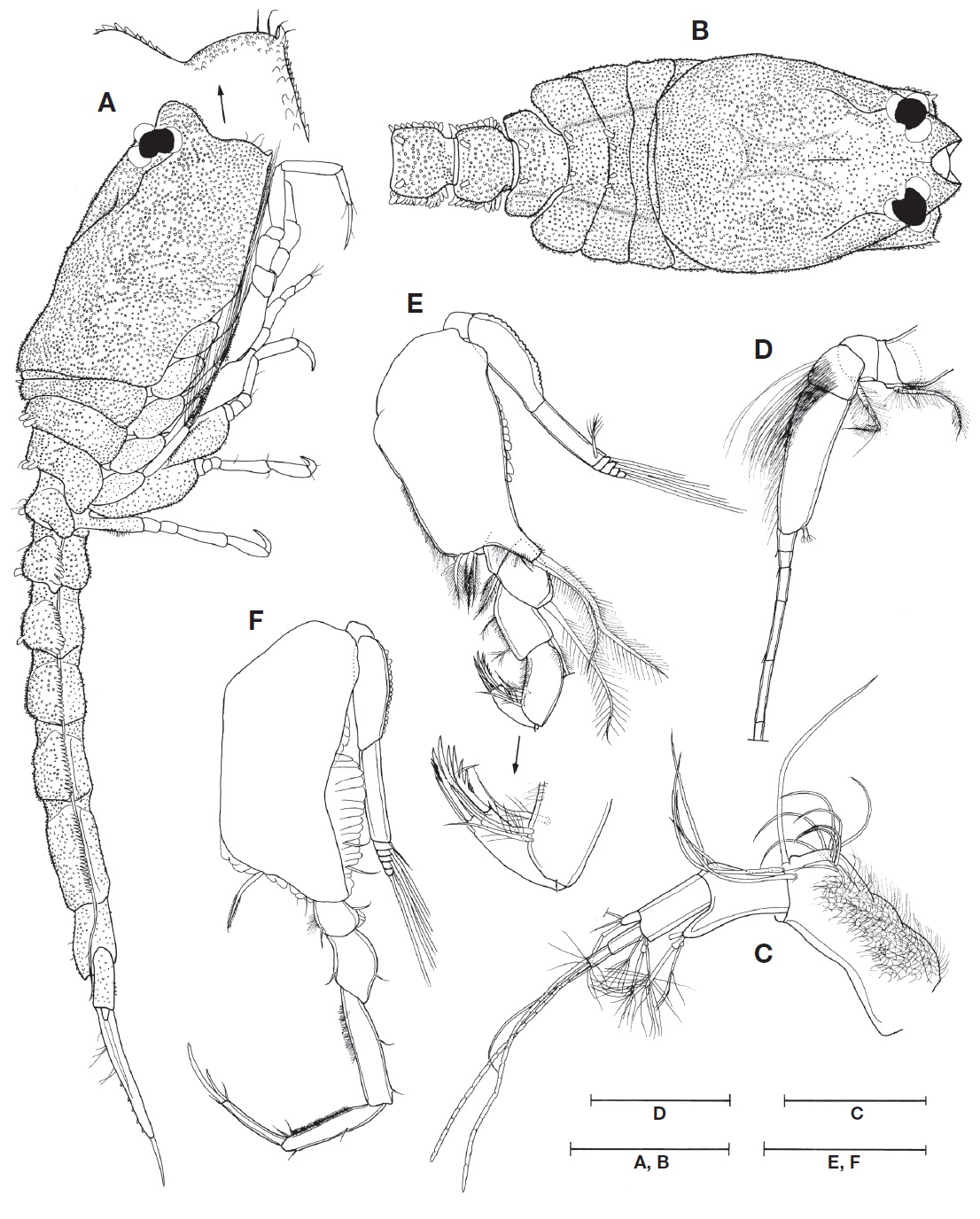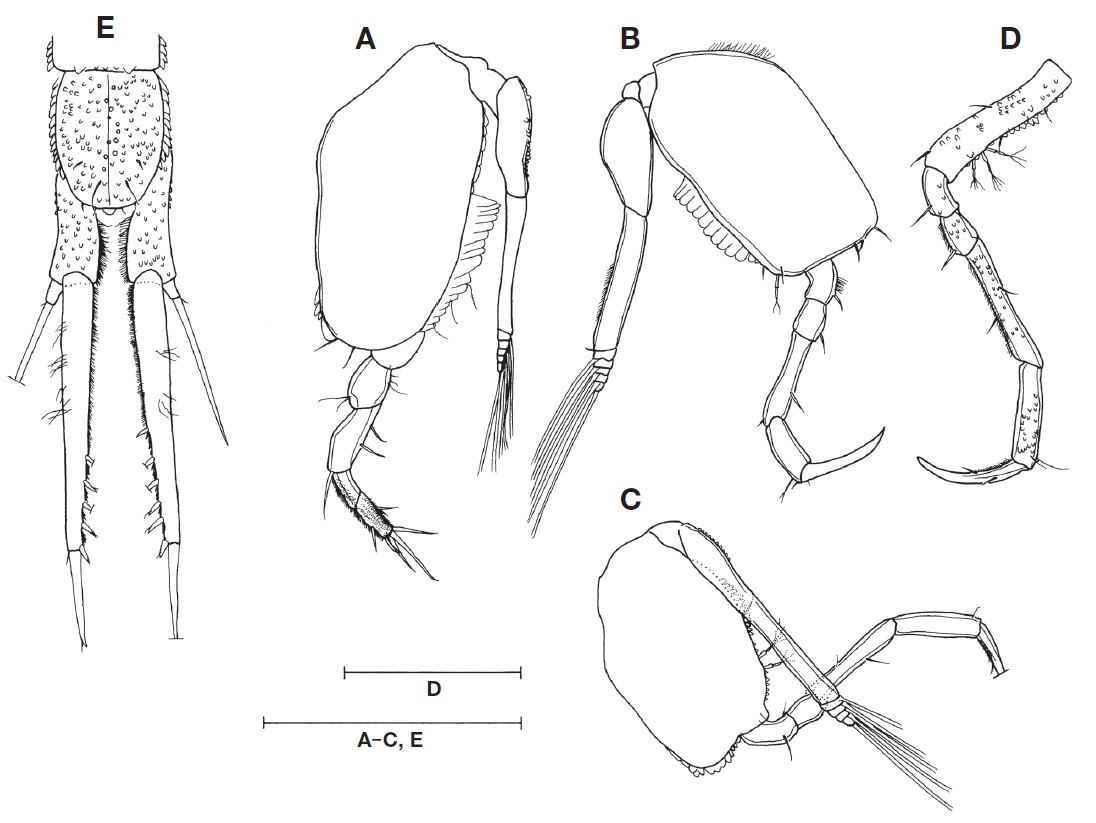



Family Nannastacidae Bate, 1866 has 25 genera with approximately 430 species worldwide (Gerken, 2012). Among the 25 genera,
>
Material examind. Korea: 31♂♂, Chungcheongnam-do: Taean-gun, Anmyeondo Island, 13 Sep 1996, Lee CM; 2♂♂, 1♀, Boryung-si, Hyojado Island, 30 May 1997, Lee CM; 4♂♂, Boryung-si, Daecheon Port, 4 Jul 1997, Lee CM; 63♂♂, Seocheon-gun, Hongwon Port, 20 Jun 1998, Kim YH; 5♂♂, Boryung-si, Daecheon Port, 9 Sep 1999, Kim YH; 21♂♂, Jeollabuk-do: Buan-gun, Gyeokpo Port, 21 Jun 1993, Kang BJ; 27♂♂, Jeollanam-do: Wando-gun, Namchang Port, 20 May 1998, Lee CM; 208♂♂, Wandogun, Cheongsando Island, 20-23 May 1998, Lee KS; 47♂♂, 3♀♀, Goheung-gun, Sinyang Port, 10 Aug 1998, Kim YH; 1♂, Yeosu-si, Ando Island, 1 Aug 2000, Kim YH; 1♂, 1♀, Yeosu-si, Anpo Port, 20 Mar 2004, Kim YH; 8♂♂, Gyeongsangnam-do: Tongyeong-si, Chubongdo Island, 10 Jul 1998, Lee CM; 12♂♂, Namhae-gun, Pyeongsan Port, 14 Jul 1999, Kim YH; 6♂♂, 2♀♀, 1 Juv., Geoje-si, Daepo Port, 18 Jul 1999, Kim YH; 196♂♂, 18♀♀, Tongyeong-si, Maemuldo Island, 28 Jun 2002, Kim YH; 1♂, Tongyeong-si, Tongyeong Port, 6 Aug 2003, Eun Y; 67♂♂, Busan-si, Dadaepo Port, 14 Mar 1993, Kang BJ; 2♀♀, Busan-si, Dadaepo Port, 28 Jul 2000, Kim YH; 140♂♂, Busan-si, Gadeokdo Island, 30 Jul 2000, Kim YH.
Description. Adult female (cat no. DKUCUM 201601): body (Fig. 1A) about 1.7 mm long, excluding uropods; surface (Fig. 1A, B) covered with numerous minute granules and several simple setae. Carapace (Fig. 1A, B) subequal to 1/3 of body length, 1.15 times as long as width, 1.55 times as long as depth; width 1.35 times as long as depth; subtriangular in dorsal view, swollen near both branchial regions, raised at median-rear portion. Antennal notch (Fig. 1A, B) deeply concave; antero-lateral margin subrectangular, serrate, with 1 strong tooth and 6 simple setae. Pseudorostral lobes (Fig. 1A, B) short, directed slightly upward, with several serrations on terminal margin. Ocular lobe (Fig. 1A, B) very broad, composed of 2 eyes having 3 lenses.
Thorax (Fig. 1A, B) almost half length of carapace, slightly shorter than 1/5 of body; lateral margins strongly serrated. Pereonite 1 very short, concealed in lateral view; pereonites 2-5 with 1 pair of obtuse teeth dorsodistally, respectively. Abdomen (Fig. 1A, B) subequal in length to cephalothorax; pleonites 1-2 with 2 pairs of obtuse teeth on dorsal and lateral surfaces, respectively; pleonite 6 with 2 pairs of simple setae on dorsal surface.
Pereopod 1 (Fig. 1C): basis 0.45 times as long as remaining articles combined, with 1 row of serrations and 1 simple proximal seta medially. Ischium with 2 simple setae. Merus with 3 simple setae. Dactylus 0.70 times as long as propodus, with 2 simple and 1 long stout setae terminally.
Pereopod 2 (Fig. 1D): basis 1.15 times as long as remaining articles combined, with 1 row of hyaline flattened teeth, outer margin with 1 simple seta distally, inner margin with 5 simple setae. Dactylus 1.65 times as long as propodus, with numerus hairs, 1 medial, 2 lateral, and 4 terminal setae.
Pereopod 3 (Fig. 1E): basis 0.40 times as long as remaining articles combined, inner margin with 1 simple seta, outer margin with 2 simple setae and 2 complex pedunculate setae.
Uropod (Fig. 1F): peduncle short, subequal in length to half of pleonite 6, inner margin with numerous hairs. Endopod not articulated, 2.40 times as long as peduncle, inner margin serrated, with 1 short simple, 2 complex pedunculate, and 1 small stout setae; terminal margin with 1 small simple and 1 long stout setae. Exopod not articulated, very short, subequal to 1/9 length of endopod, with 1 short and 1 long stout setae (reaching to about 5/6 point of endopod) terminally.
Adult male (cat no. DKUCUM 201602): body (Fig. 2A) about 2.4 mm long, excluding uropods; surface (Fig. 2A, B) same as in female. Carapace (Fig. 2A, B) subequal to 1/3 length of body, 1.40 times as long as width, 1.80 times as long as depth; width 1.25 times as long as depth; subrectangular in dorsal view, swollen near both branchial regions. Antennal notch (Fig. 2A, B) shallowly concave; antero-lateral margin subrectangular, serrate, with 1 strong tooth and 4 simple setae. Pseudorostral lobes (Fig. 2A, B) and ocular lobe (Fig. 2B) same as in female.
Thorax (Fig. 2A, B) almost half length of carapace, 1/5 length of body. Pereonite 1 very short, concealed in lateral view; pereonite 2 with 1 pair of dorsal teeth; pereonites 3-4 with 2 pairs of obtuse teeth dorsodistally, respectively; pereonite 5 long, with 1 pair obtuse teeth dorsodistally, respectively. Abdomen (Fig. 2A, B) subequal in length to cephalothorax; pleonites 1-2 with 1 pair of obtuse teeth dorsodistally, respectively; pleonite 6 with 2 pairs of simple setae dorsodistally and 2 pairs of small setae terminally, respectively; pleonites 1-6 with lateral serrated grooves.
Antenna 1 (Fig. 2C): peduncle composed of 3 articles; first article slightly shorter than remaining articles combined, with numerous hairs, and with 11 simple distal setae in outer margin; second article 0.45 times as long as first one, with 2 simple setae on outer corner; inner corner very inflated, longer than 1/2 length of third article, with 3 complex pedunculated setae distally; third article subequal in length to second one, with 3 complex pedunculate setae on distal margin. Main flagellum composed of 2 articles, slightly longer than last article of peduncle; second article with 1 simple seta and 2 aesthetascs terminally. Accessory flagellum not articulated, with 2 simple and 1 complex pedunculate setae.
Antenna 2 (Fig. 2A, D) slightly extending beyond end of pleonite 6; peduncle 5-articulate, second and third articles with 1 pappose seta.
Maxilliped 3 (Fig. 2E): basis slightly longer than remaining articles combined, outer margin with 1 row of serrations, inner margin with numerous hairs and 3 distal plumose setae; outer corner very inflated, reaching to about 1/2 length of merus, with 2 long plumose setae. Ischium with 1 plumose seta on inner coner. Merus with 1 plumose seta on inner margin and 1 long plumose seta on outer coner. Dactylus with 1 simple, 1 microserrate, 2 long stout, and 1 serrate setae terminally.
Pereopod 1 (Fig. 2F): basis 0.70 times as long as remaining articles combined, with 1 row of serrations, 1 row of hyaline flattened teeth, and 2 distal simple setae on outer margin, 1 microserrate seta and 1 row of serrations near distal margin. Ischium and merus with 2 simple setae. Dactylus 0.70 times as long as propodus, with 3 simple and 1 long stout setae terminally.
Pereopod 2 (Fig. 3A): basis subequal in length to remaining articles combined, with 1 row of serrations, 1 row of hyaline flattened teeth, and 3 distal simple setae on outer margin, 1 row of serrations and 2 simple distal setae near inner corner. Dactylus 1.55 times as long as propodus, with numerus hairs, 1 medial, 2 lateral, and 4 terminal setae.
Pereopod 3 (Fig. 3B): basis 0.90 times as long as remaining articles combined.
Pereopod 4 (Fig. 3C): basis 0.75 times as long as remaining articles combined.
Pereopod 5 (Fig. 3D): basis 0.45 times as long as remaining articles combined.
Uropod (Fig. 3E): peduncle 0.86 times as long as pleonite 6, with numerous hairs on inner margin. Endopod not articulated, 2.50 times as long as peduncle; inner margin serrated, with 5-6 small stout setae; terminal margin with 1 small simple and 1 long stout setae. Exopod not articulated, very short, subequal to 1/13 length of endopod, with 1 short setae and 1 long stout seta (reaching to about 3/5 point of endopod) terminally.
Distribution. Korea (South Sea, Yellow Sea), Japan (Gamȏ, 1962, 1967), Malaysia (Petrescu, 2003), Madagascar (Petrescu, 2003).
Remarks. Korean female specimens of
Korean name:1*두눈올챙이새우속 (신칭), 2*두드러기두눈올챙이새우 (신칭)


